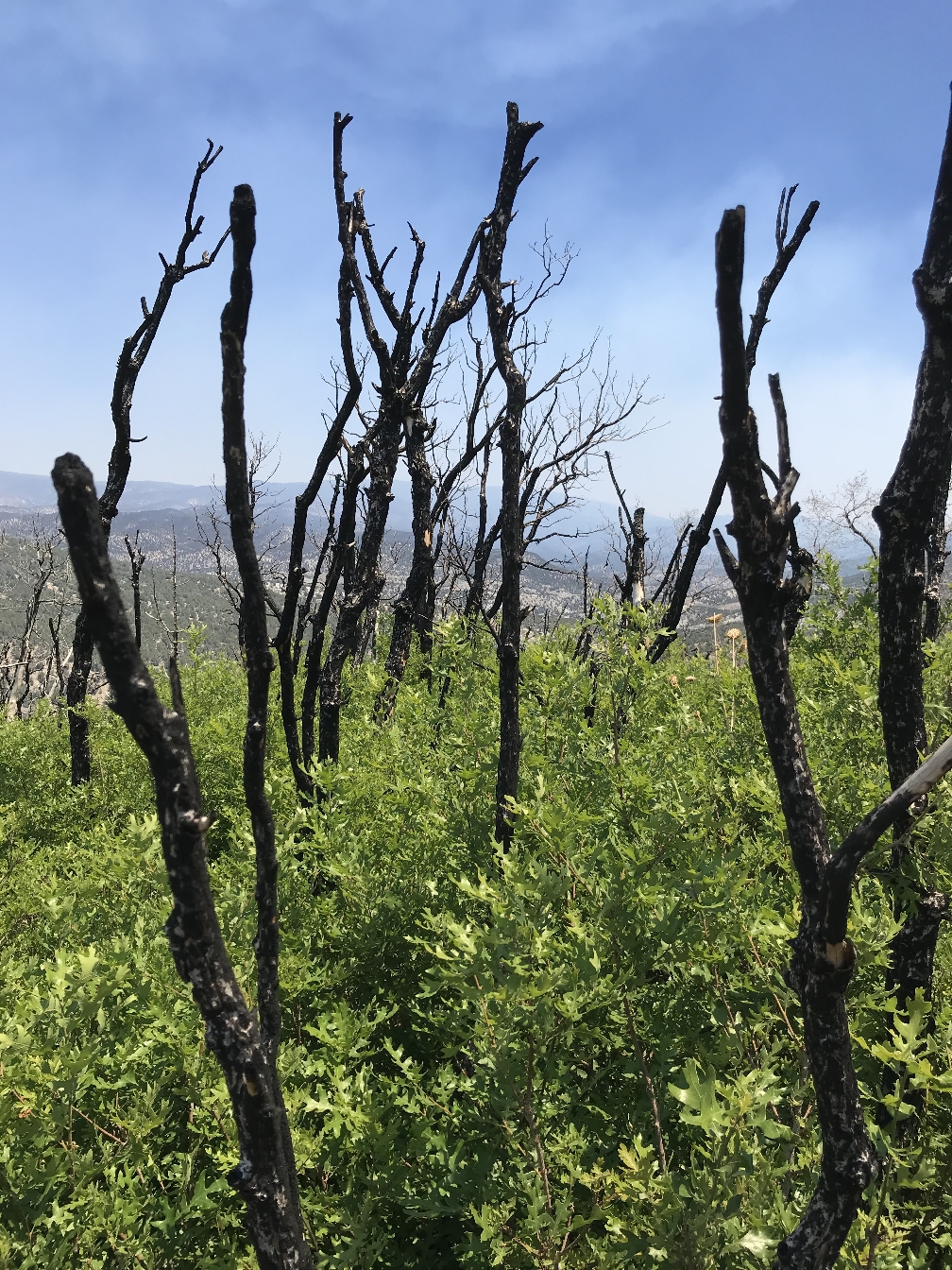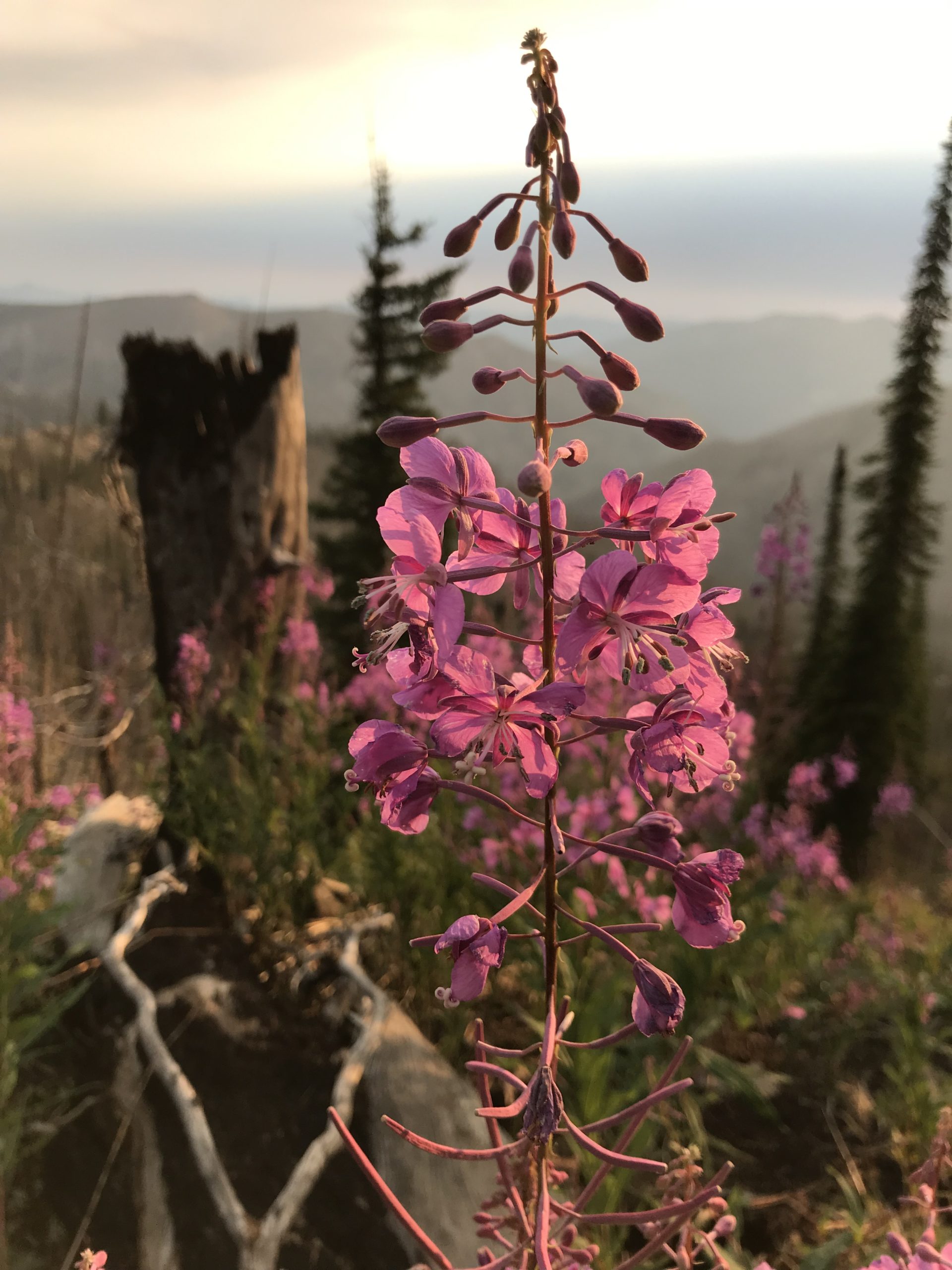
Quercus gambelii
Courtesy & © Shannon Rhodes, Photographer
 Fireweed
Fireweed
Epilobium angustifolium
Courtesy & © Shannon Rhodes, PhotographerToday snow blankets Utah’s forest floors, yet just a few months ago wildfire management teams were battling blazes across the state. With over 1,000 wildfires burning an estimated 63,000 acres in Utah in 2021, it was not difficult to find one. As I observed plumes of the Bennion Creek fire from a safe, comfortably cool spot atop Manti-LaSal’s Skyline Drive last June, Disney’s Bambi wildfire came to mind. Wildlife no doubt scurried while humans raced against windy conditions, hoping to contain as others evacuated, all bracing for inevitable short-term as well as long-term impacts. Smokey the Bear campaigns have called for prevention and suppression since the 1940s, and reports showed that human-caused wildfires were fewer in 2021 than previous years, yet nature itself is still sometimes to blame.
Yesterday as I visited with a close friend grieving her daughter’s recent and abrupt passing, we reflected on a summertime adventure we shared through an alpine burn scar, blackened, silent, and desolate. We wandered again through our memory of acres and acres of torched forest. Regally standing amid the charred stumps and nothing else, though, were thousands of beautifully bright pink-purple flower colonies. William Shakespeare’s poetic
“Here enclos’d, in cinders lie.
Death is now the Phoenix’ nest,”
describes this hardy plant named fireweed, not for any fiery red-orange blossoms but for being a colonizer of recently-scorched landscapes. Long before grasses, Gambel oak, and Lodgepole cone sprouts start to emerge out of the ashes, flashy fireweed will grow to sometimes nine feet tall. The flowers bloom from bottom up, and when the top flower bud blooms, winter might be just six weeks away. Also called willowherb, fireweed seed heads are long pods filled with silky feather tufts that unfold to carry tens of thousands of seeds on the wind, signaling the end of the season. As time passes, other plants will take over as successive vegetation cycles do, but once you’ve seen majestic fireweed thrive in an annihilated forest, you never forget it. Wildlife loves fireweed just as much as I do. Deer, elk, moose, and even grizzly bear along with all sorts of pollinators are attracted to her deliciously vibrant color.
January is a quiet reprieve from summer blazes, a time when renewal and rebirth is our focus. Right now forest phoenix fireweed seeds are just awaiting the thaw, eager to bring solitary but stately vitality to otherwise dismal gloom. Out of something devastating comes a little bit of lovely. After World War II bombings, fireweed bloomed in the heart of London for the first time in decades. I imagine my friend’s Crystal and fireweed would agree: Why be a princess among others when you can be the queen?
I’m Shannon Rhodes, and I am Wild About Utah.
Credits:
Images: Courtesy & Copyright © Shannon Rhodes, Photographer
Audio: Courtesy & © Friend Weller, https://upr.org/
Text: Shannon Rhodes, Edith Bowen Laboratory School, Utah State University https://edithbowen.usu.edu/
Additional Reading Links: Courtesy Shannon Rhodes
Additional Reading:
Ballard, Heidi L., Emily Evans, Victoria E. Sturtevant, and Pamela Jakes (2012). The Evolution of Smokey Bear: Environmental Education About Wildfire for Youth, The Journal of Environmental Education, 43:4, 227-240, DOI: 10.1080/00958964.2011.644352, https://www.tandfonline.com/doi/full/10.1080/00958964.2011.644352?casa_token=4uSEKZ1Po3QAAAAA%3Al5k-XuM1LI80cCIZD3Ywg4E_3shIs8S-h-iVQ7uumEhvN-mGmaogdve04Y9tEeUqlxA2Li0Y3PVv
Boling, Josh. Fire. Wild About Utah, August 13, 2018, https://wildaboututah.org/fire/
Capdeville, Sarah. Fireweed: A Colorful Reminder of Change. (2015). https://www.mtpr.org/arts-culture/2015-06-05/fireweed-a-colorful-reminder-of-change
Collard, Sneed B. Fire Birds: Valuing Natural Wildfires and Burned Forests. (2015). Bucking Horse Books. https://www.amazon.com/Fire-Birds-Valuing-Natural-Wildfires/dp/0984446079
Green, Jack. Holy Smokes! (2021). https://wildaboututah.org/holy-smokes/
Mullen, Luba. How Trees Survive and Thrive After a Fire. (2017). https://www.nationalforests.org/our-forests/your-national-forests-magazine/how-trees-survive-and-thrive-after-a-fire
Olsen, Shawn and Debbie Amundsen. Gambel Oak in the Landscape. (2021). USU Extension. https://digitalcommons.usu.edu/cgi/viewcontent.cgi?article=1905&context=extension_curall
Peery, Lexi. Utah Saw a Decrease in Human-caused Wildfires. November 2, 2021. https://www.kuer.org/health-science-environment/2021-11-02/utah-saw-a-decrease-in-human-caused-wildfires-this-year-but-officials-say-fire-season-isnt-going-away
Shakespeare, William. The Phoenix and the Turtle. (1601). https://www.poetryfoundation.org/poems/45085/the-phoenix-and-the-turtle-56d2246f86c06
U.S. Department of Agriculture. Fireweed. (2016). https://www.nrcs.usda.gov/Internet/FSE_PLANTMATERIALS/publications/wapmspg12854.pdf
Vizgirdas, Edna. U.S. Forest Service Plant of the Week: Fireweed. https://www.fs.fed.us/wildflowers/plant-of-the-week/chamerion_angustifolium.shtml
Wells, Kathryn and Timothy J. Haney. D is for Disaster. (2017). https://journals.sagepub.com/doi/full/10.1177/1536504217714262 Volume: 16 issue: 2, page(s): 62-64. (2017).
Wild About Utah Posts by Shannon Rhodes https://wildaboututah.org/author/shannon-rhodes/
